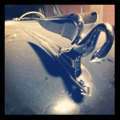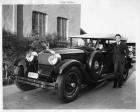|
Re: Ohms of resistance for 54 Patrician temp sender
|
||||
|---|---|---|---|---|
|
Just can't stay away

|
I can confirm that TS6464 from Napa as well as the Standard Motor Products TS-4 work just fine, as I've used both, and they read about the same. I had previously been using an aftermarket gauge (Sunpro) which after a few months of use happened to fail on the way to the PAC Western Regions tour. Napa got a TS6464 in for me at 8am the next day and I installed it in the parking lot.
In my '52, the gauge reads the following at these approximate levels of resistance: (readings correlated to the letters TEMP) -35 ohms = "T" -29.7 ohms = Left edge of "E" -24.2 ohms = Between "E" and "M" -18.5 ohms = "M" -14.2 ohms = "P" -8 ohms = pegged on/past the H mark Incidentally, the sender I tested read about 14 ohms at 212 degrees, and 25 ohms at around 170 degrees.
Posted on: 2015/8/20 2:00
|
|||
|
||||
|
Re: 1954? radiator- does anyone know what this is from?
|
||||
|---|---|---|---|---|
|
Just can't stay away

|
I have heard the rumor often repeated that the Korean War radiators were thinner material compensated for with the larger fan, but I've never seen an example of a Korean War radiator next to one that hadn't been lightened/cheapened. I would figure my 52 would have whatever modifications were being performed during the war (it certainly had that lousy chrome), but my radiator looks just like the ones for the later cars. What are the part numbers or other identifying marks that denote one of these war radiators?
Posted on: 2015/8/18 0:52
|
|||
|
||||
|
Re: Voltage regulator
|
||||
|---|---|---|---|---|
|
Just can't stay away

|
You are correct -- that part number is not the correct regulator for a Delco-equipped car (it is, however, basically the right one for an Autolite-equipped car). In looking at the Specifications section of the service manual, I pulled the part number for the regulator that originally came in your car. That part number crosses to a Standard Motor Products VR8, Napa Echlin VR1071, and various others. Using this information, you can likely get O'Reilly or whatever parts house you use to cross one of those two new numbers to whatever line they carry.
Posted on: 2015/8/12 10:14
|
|||
|
||||
|
Re: What is this for? The thread..
|
||||
|---|---|---|---|---|
|
Just can't stay away

|
That's the windshield wiper control (and the windshield washer control if you have that option). Turn it clockwise to start the wipers.
You can find more info in the owners manuals which are available elsewhere on this site.
Posted on: 2015/8/8 1:50
|
|||
|
||||
|
Re: 54 patty transmission fluid
|
||||
|---|---|---|---|---|
|
Just can't stay away

|
Quote:
I'm very confused here. Ford didn't release or use transmission fluids without friction modifiers until 1961, long after Packard had left the business. Packard spec'd Type A, which IS a friction-modified fluid. Type A, which was a specification developed by General Motors for their own automatic transmissions originally released in 1949, used sperm whale oil as a friction modifier or "slip agent" as you call it. It wasn't the greatest of fluids - it degraded quickly, it had a low shear strength, it was prone to viscosity breakdown, etc. When its oxidation performance was upgraded in 1957, the specification became Type A/Suffix A, which became somewhat the world standard until the standard was upgraded further and renamed Dexron in 1967. The Dexron line is the successor to Type A, as far as I can tell, and even General Motors has specifically declared that Dexron III is backward compatible with all previous Dexron specifications back to Type A. So at a minimum, it's debatable whether Type F is the closest modern equivalent to Type A -- because the Type F spec hasn't been revised since 1967, it probably is more closely comparable to the original Type A fluids in that the standard sets relatively low limits on oxidation performance, viscosity stability, wear reduction, heat breakdown, etc. It is, however, generally accepted that using Type F in a transmission originally designed for a friction modified fluid (as Ultramatics were) will not do any real harm other than firming up the shift quality. However, friction modified fluids should never be used in a transmission that was designed to take Type F -- it will destroy the clutches in very short order.
Posted on: 2015/8/3 10:59
|
|||
|
||||
|
Re: Automotive Driving Museum
|
||||
|---|---|---|---|---|
|
Just can't stay away

|
Indeed, the 1951 Packard 300 we have was not a police car to begin with. We had a nice driving car that needed a paint job, so we thought it would be fun to make it into a police car. The museum's curator, Earl Rubenstein (also a trustee emeritus of PAC), found all the parts at swap meets and had the car turned into a Secret Service car. Earl took the car on the Packard Club All-Western Region tour last year-- it made quite the splash both on and off the highway, and like a Packard should, it made the 800 mile round trip without any issues whatsoever.
Posted on: 2015/7/26 9:34
|
|||
|
||||
|
Re: What kind of oil to use? 1941 Packard 110
|
||||
|---|---|---|---|---|
|
Just can't stay away

|
There are many posts on this site already discussing various brands and viscosity grades of oils, which I highly recommend reading, but here are some of the key takeaways:
-Detergent oil wasn't commercially available when the owners manual was printed, but has been used successfully for many miles by folks on this forum. Detergent oils help prevent and dissolve sludge -Multi-weight (e.g., 10W-30) engine oil didn't exist when the owners manual was printed but is a better choice than a single weight oil if you have any real variation between low and high temperatures between day and night -There have been significant advances in engine oil technology since that time -A 10W-30 would be fine for this engine if daytime temperatures don't regularly get above 90 degrees F, otherwise a 10W-40 or 15W-40 is a good choice. -Mixed fleet diesel/gasoline oils (I.e., those which are primarily meant for diesel vehicles but which also carry an API SL, SM, or SN rating) are an excellent choice because they have the levels of ZDDP some people feel is necessary in these old cars. -Shell Rotella T Triple Protection, Mobil Delvac, and Chevron Delo are all widely available, well-respected brands, which offer oils in this space.
Posted on: 2015/5/16 0:53
|
|||
|
||||
|
Re: Fuel mileage for '51-54
|
||||
|---|---|---|---|---|
|
Just can't stay away

|
I've tracked every fill up for my '52 Patrician (327 Ultramatic) for the past three years, and the best mileage I've gotten was 15.1 mpg, which was on three tanks of exclusively highway driving at 60-65 mph during a Packard Club tour last year. Each tank came out exactly the same, 15.1 mpg.
The worst I've seen is 8.6 mpg, which was exclusively city driving and prolonged idling. My average for about two years was 10 mpg in mixed driving, although lately I've been seeing around 11 mpg regularly.
Posted on: 2015/5/13 8:22
|
|||
|
||||
|
Re: Single Stage Paint? Good idea? Bad idea?
|
||||
|---|---|---|---|---|
|
Just can't stay away

|
I have very little experience with shopping paint options, but I can tell you that my personal experience is that I haven't been particularly pleased with the single stage paint on my car. It was repainted several years ago with what most people today would call "the good stuff" but the paint is much softer than a modern base over clear would be. Every time I have to do any appreciable work under the hood, I end up having to re-polish the fenders because all the fender covers I've tried put micro-scratches into the paint. I also find that the paint chips easily. This could all be the result of aging or poor application way back when, but it still underscores the point -- you want the best job you can afford.
Posted on: 2015/2/17 2:51
|
|||
|
||||








